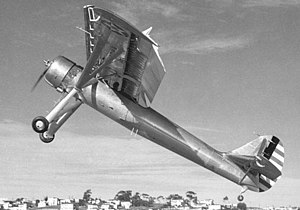|
Ryan YO-51 Dragonfly
The Ryan YO-51 Dragonfly was an observation aircraft designed and built by Ryan Aeronautical for the United States Army Air Corps (USAAC). A single-engined parasol wing monoplane, it was designed for optimum STOL capability, but although three prototypes proved highly successful in testing, the Stinson YO-49 was judged superior and no production contract was placed. DesignThe design of the YO-51 Dragonfly was typical for aircraft of its type, being optimised for the observation and liaison role, with emphasis on the ability to operate out of the smallest possible airfields.[1] The Dragonfly was a high-wing braced parasol monoplane with fixed tailwheel landing gear, a two-seat open cockpit, and full-span slots and Fowler flaps for STOL capability.[2] It was powered by a single Pratt & Whitney R-985-21 Wasp Junior radial engine.[3] At gross weight, the YO-51 could, without flaps, take off after a run of 400 feet, while with full flaps the takeoff run would be only 75 feet, or just four feet more than twice its own length.[4] The Dragonfly was capable of maintaining level flight at speeds as low as 30 miles per hour (48 km/h),[5] and was claimed as being capable of landing in a distance shorter than the length of the aircraft itself.[6] Operational historyNicknamed the "flying motorcycle",[7] three YO-51 aircraft were acquired by the United States Army Air Corps to take part in a fly-off evaluation against the Stinson YO-49 and Bellanca YO-50 to supply a new observation and liaison aircraft for use by the USAAC.[8] The YO-51 was the heaviest of the three aircraft evaluated.[9] Although the Dragonfly was considered satisfactory during its flight testing,[10] conducted at Wright Field in Ohio,[11] the Stinson machine won the production contract, and no further YO-51s were built.[12] Specifications Data from Donald 1997[3] General characteristics
Performance
Armament
See alsoAircraft of comparable role, configuration, and era
Related lists References
External linksWikimedia Commons has media related to YO-51 Dragonfly.
|
||||||||||||||
